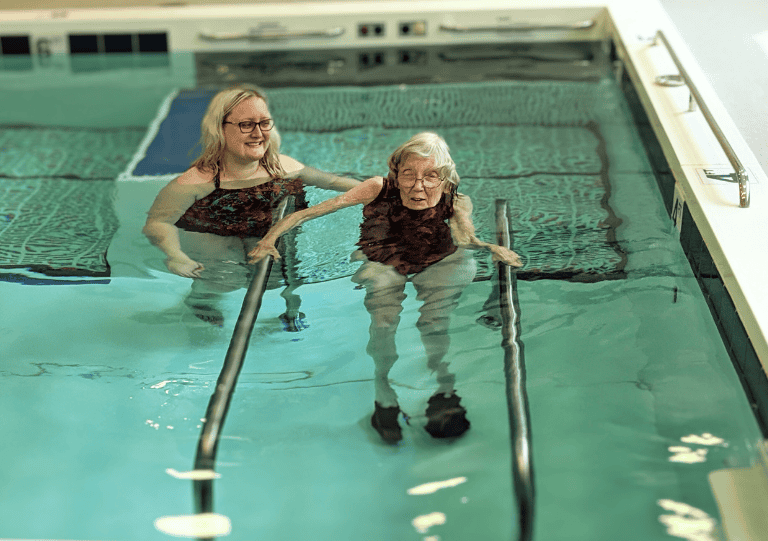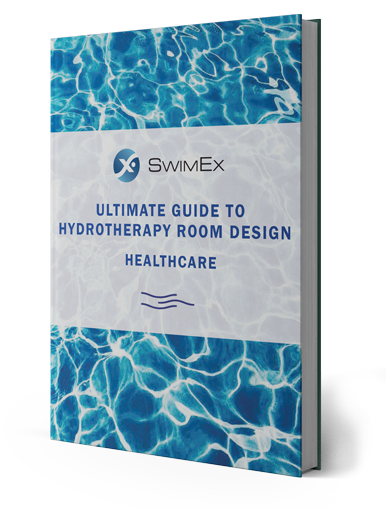
Hydrotherapy—also known as aquatic therapy—is emerging as one of the most powerful tools in the treatment of cerebral palsy (CP), offering a safe and effective way to support mobility, reduce pain, and build confidence. For individuals living with cerebral palsy, water provides a space where limitations can be reduced, movement becomes more fluid, and physical therapy becomes more accessible.
Real-Life Impact: Nina’s Story
At Seabury Retirement Community, physical therapist Katrina has seen the impact of hydrotherapy for cerebral palsy firsthand. One of her patients, Nina, has lived with cerebral palsy for most of her life. The increased tone in her body has made walking difficult and caused musculoskeletal deformities over time.
“Putting her in the water allows us to decrease that tone and really get in good stretching,” explains Katrina. “These are things she could never tolerate on land because it would be dangerous and uncomfortable.”
Nina initially came to Seabury for rehabilitation after breaking her hip. But when it came time to choose a long-term residence, her decision was made for one key reason: the pool.
“I decided Seabury would be a good place, and the number one reason I chose it was because of the pool,” says Nina. “It’s been such a help to me.”
Nina’s physical therapy takes place in a SwimEx 1000 T hydrotherapy pool, equipped with the SwimEx adjustable current. This allows physical therapists to customize resistance and direction based on the patient’s needs. If Nina is struggling with balance in a certain direction, Katrina adjusts the current to challenge Nina and improve her stability—safely.
“This motion pool is wonderful,” says Nina. “It helps me keep my balance. I’m always trying to stay upright. It trains me to work against the current, which is so good. And if I fall, I’m not going to hurt myself because it’s just water.”
Since her hydrotherapy sessions, Nina’s pain has decreased, her mobility has improved, and she continues to benefit with every session. “I love it,” she says. “I look forward to it every week. I’m one of their best advocates.”
Why Hydrotherapy for Cerebral Palsy?
Hydrotherapy uses the properties of water—buoyancy, resistance, and warmth—to create a therapeutic environment for movement. For individuals with cerebral palsy, this means:
- Reduction in spasticity
- Enhanced muscle strength and endurance
- Increased range of motion
- Safer practice of balance and posture
Water helps support the body in a way that land-based exercises can’t, making physical therapy more comfortable and effective for people of all ages and ability levels.
One of the most significant benefits of hydrotherapy for cerebral palsy is the reduction in spasticity. Immersion in warm water—ideally between 33°C to 35°C—helps decrease muscle spindle activity. This leads to noticeable muscle relaxation. With less tone, individuals can move more freely. It also improves joint mobility, posture, and overall comfort during therapy.
Additionally, spasticity often limits range of motion and increases fatigue. The soothing environment of a hydrotherapy pool makes movement safer and more manageable. This opens new possibilities for functional gains and improved quality of life. A study published by the National Institutes of Health supports these findings, highlighting the therapeutic value of warm water immersion in reducing muscle tightness and improving outcomes.
According to Cerebral Palsy Guidance, aquatic therapy also supports emotional and psychological well-being. The calming, weightless environment helps ease anxiety and reduce the fear of falling. It also builds confidence through safe, successful movement experiences.
Regular sessions can foster a stronger sense of independence. They may also improve sensory integration and offer opportunities for social connection—especially in group settings. For many individuals with cerebral palsy, these mental and emotional benefits are just as powerful as the physical ones.
The SwimEx Difference
Not all hydrotherapy pools are created equal. At Seabury Retirement Community, physical therapists use the SwimEx 1000 T, a pool large enough to individually treat multiple patients during the same session. SwimEx also offers smaller pool models equipped with the same signature paddlewheel current, making hydrotherapy for cerebral palsy accessible in facilities of any size.
Unlike traditional jets that provide a narrow stream of pressure, the SwimEx paddlewheel current delivers consistent, adjustable resistance that surrounds the entire body. This unique design allows physical therapists to focus on specific challenges related to balance, coordination, and strength with a high degree of precision.
As Katrina describes, “With the SwimEx current, I can turn it on and direct the resistance exactly where Nina needs it. Whether she’s working on forward balance, side-stepping, or building postural control, the current helps in every direction.”
This level of customization makes SwimEx an ideal choice for senior living communities, hospitals, and physical therapy clinics supporting individuals with cerebral palsy and other neurological conditions.
Frequently Asked Questions About Hydrotherapy for Cerebral Palsy
Is hydrotherapy safe for people with severe cerebral palsy?
Yes—when supervised by a licensed physical therapist and conducted in a properly designed pool, hydrotherapy is safe and highly effective even for individuals with limited mobility.
How often should hydrotherapy be used?
Frequency depends on the individual’s needs and care plan, but many benefit from sessions 1–3 times per week.
Can hydrotherapy replace other physical therapy?
Hydrotherapy is best used as part of a comprehensive physical therapy plan and may enhance the effectiveness of other treatments.
A Path Toward Greater Mobility and Confidence
For individuals like Nina, hydrotherapy offers more than just exercise—it offers freedom, relief, and confidence. Her story is one of many that demonstrate the profound impact of this approach.
At SwimEx, we’re proud to be part of that journey. Hospitals, retirement communities, and pediatric clinics choose SwimEx to support real progress and empower people with cerebral palsy to move forward—one session at a time.
Want to learn more about how hydrotherapy can help your patients with cerebral palsy? Contact us to explore custom pool options for your rehabilitation facility or senior living center.
~ Contribution from Thomas J Marston, PT, DPT, MS. Thomas graduated with honors from Boston University College of Health and Rehabilitation Sciences in 1994, with a Master’s degree in Physical Therapy. He received his Doctorate of Physical Therapy from SUNY Upstate in 2010. He has more than 29 years of experience.
Free Guide
Hydrotherapy For Healthcare
The ultimate guide for designing and planning a room for your healthcare facility from start to finish.

